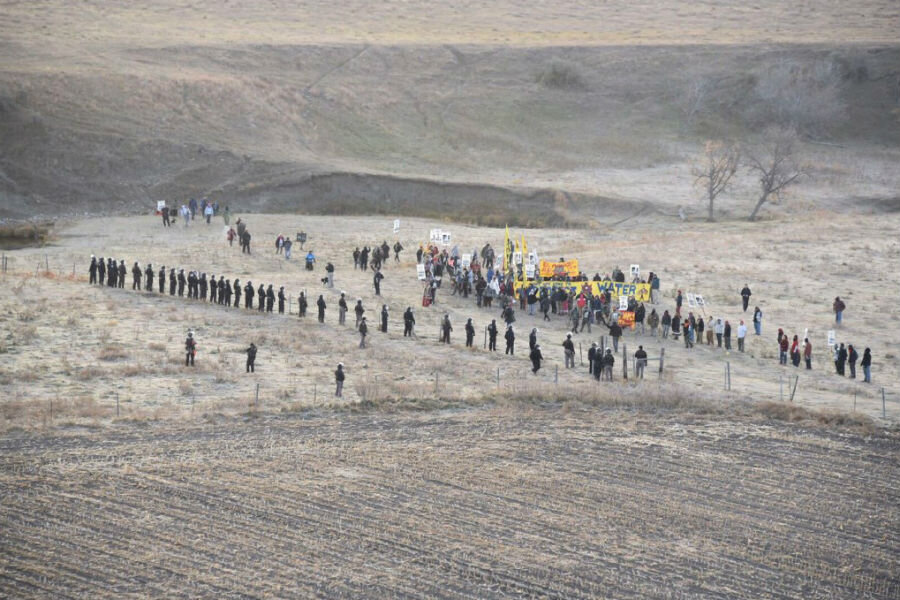Standing Rock protests escalate, as tribe calls for DOJ to investigate
Loading...
The protests against the controversial Dakota Access Pipeline have now been raging for months. Like any longstanding protest, there are ebbs and flows in tensions between law enforcement and the members and supporters of the Standing Rock Sioux Tribe.
The most recent escalation over the past week culminated in the arrest of 127 protesters on Saturday, in a move condemned by the tribe as a disproportionate and unnecessary show of force by local law enforcement. Tribal leaders called on the US Department of Justice to intervene on behalf of the protesters.
So far, the Justice Department has largely stayed out of the conflict between protesters, local law enforcement officials, and the corporate interests backing the pipeline. But for so many Native Americans, the pipeline evokes historical wrongs associated with the US federal government's past policies, and what they believe is an unaddressed need for the federal government to fully acknowledge that turbulent past, and help native communities overcome the challenges they face today.
The Saturday arrests came after 300 protesters reportedly crossed through private property along the pipeline project's construction path. Charges against those arrested include assault on a peace officer, criminal trespassing, and engaging in a riot. Morton County Sheriff Kyle Kirchmeier reporters that the Saturday incident was an indicator that the protesters were not behaving in a "peaceful or lawful" manner.
Standing Rock Sioux tribe leaders, on the other hand, blame local law enforcement for any escalation of the conflict.
"The militarization of local law enforcement and enlistment of multiple law enforcements agencies from neighboring states is needlessly escalating violence and unlawful arrests against peaceful protesters at Standing Rock," Standing Rock Sioux Tribal Chairman Dave Archambault II said in a statement. "We do not condone reports of illegal actions, but believe the majority of peaceful protesters are reacting to strong-arm tactics and abuses by law enforcement."
The Dakota Access Pipeline standoff began in July, when the planned 1,200-mile long pipeline's course was shifted over concerns that its original route could pollute the Missouri River in the event of a rupture, which could have contaminated the state capital's drinking water. The pipeline route was then shifted to a route within a half-mile of the Standing Rock Sioux reservation.
"The Standing Rock Sioux Tribe is deeply concerned about the construction of a major crude-oil pipeline that passes through their ancestral lands," reads the FAQ of the tribe's website. "There are two broad issues. First, the pipeline would pass under the Missouri River (at Lake Oahe) just a half a mile upstream of the Tribe’s reservation boundary, where a spill would be culturally and economically catastrophic. Second, the pipeline would pass through areas of great cultural significance, such as sacred sites and burials that federal law seeks to protect."
Soon after the protests began, more than 1,000 supporters began gathering at Sacred Stone Camp, where many clashes with police and construction officials have since taken place. Supporters have latched on to the issue of the pipeline in order to draw attention to other challenges faced by Native Americans today, as The Christian Science Monitor's Rowena Lindsay wrote earlier this month:
According to a study of US Census data by the Pew Research Center, approximately 1 in 4 native Americans live below the poverty line. On the Standing Rock Sioux Tribe reservation, that number is even higher. Similarly, native Americans have a higher unemployment rate than the national average. Faced with substandard school systems, only 53 percent of native Americans graduate high school (compared with 83 percent national average) and only 17 percent have a bachelor's degree or higher, reports Pew.
The Standing Rock protest acted as a catalyst, a call to action for many young native people who, frustrated with their circumstances, saw an opportunity to fight back against the myriad injustices they and their families have faced for generations.
Involving the Department of Justice might bring in a potential source of legal protection against local pro-pipeline and law enforcement resistance, and provide Native Americans with a platform for interaction with the more authoritative – and perhaps more supportive – US federal government on the issue.
The Obama administration did suspend construction on the pipeline for a time, but construction was resumed on private land earlier this month, and other federal agencies have stayed relatively quiet about the protests. The Saturday arrests took place on one of these private swathes of land.
"The DOJ should impose an injunction to all developments at the pipeline site to keep ALL citizens – law enforcement and protestors – safe," said Chairman Archambault. "Preventing government agencies from stripping protestors and tribal members of their constitutional rights to organize and protect our sacred places and water is paramount to both U.S. citizens and tribal sovereignty."
At the forefront of protester's concerns are the upcoming cold winter and presidential election. Neither Hillary Clinton nor Donald Trump have openly voiced their opinion on the Dakota Pipeline issue, and Donald Trump actually has a $1 million investment in Energy Transfer Partners, whose subsidiary, Dakota Access, is behind the construction of the pipeline, according to ABC News.
If the Standing Rock Sioux tribe don't get support soon, they may face a futile fight against opponents on all sides. But camp spokesman Cody Hall told ABC earlier this month that protesters are in it for the long haul.
"The people are going to stay vigilant," Mr. Hall said. "They're going to fight this pipeline to the very end."








